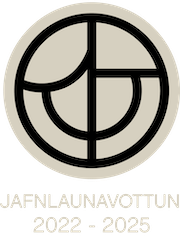Notkun stöðugra samsætna til aukins skilnings á eðlisfræðilegum ferlum í vatnshringrás andrúmsloftsins - verkefni lokið
Fréttatilkynning verkefnisstjóra
Vatnsgufa andrúmslofts er mikilvæg til að viðhalda hringrás vatns um jörðina og ein áhrifamesta gróðurhúsalofttegundin. Þekking okkar á ferlum í andrúmsloftinu er hins vegar takmörkuð, sér í lagi þegar kemur að skýjamyndun og breytilegu rakastigi veðrahvolfsins.
Þessi þekkingarskortur veldur því að spám um hlýnun jarðar ber illa saman. Bent hefur verið á að betri skilningur á þeim ferlum sem stjórna rakastigi í snertifleti sjávar og lofts (SSL) (e.marine boundary layer) sé afar mikilvægur til að auka skilning á næmni veðrakerfanna. Flókið samspil milli hafs, SSL og veðrahvolfs stjórnar rakastigi í SSL og þar með skýjamyndun. Vegna áhrifa þessa samspils á jafnvægi milli út- og inngeislunar og vegna þess að mismunandi breytileiki í næmni veðrakerfanna er tengdur því hvernig skýjamyndun er reiknuð inn í veðurfarslíkön veldur þessi þekkingaróvissa mikilli breidd í útkomu loftslagslíkana. Í verkefninu notum við nýja aðferð til að rannsaka ferli sem stjórna rakastigi í SSL á Norður Atlantshafi, með mælitækjum sem sett voru upp á Bermuda og Íslandi. Þessi aðferð býður upp á samfellda söfnun á andrúmslofti og mælingu á styrk samsæta (hlutfallinu milli þungs og létts vatns) í vatnsgufunni. Samsætur í vatnsgufu eru háðar mismunandi uppruna vatnsgufunnar og þeim ferlum sem hafa áhrif á lofthjúpinn. Samsætur veita þar af leiðandi mikilsverðar upplýsingar um rakamyndun, sem venjulega sjást ekki þegar aðeins er horft til breytileika í rakastigi. Mælingarnar sem gerðar voru í þessu Rannsóknasjóðsverkefni er fyrsta mæliröð sinnar tegundar á Norður Atlantshafssvæðinu. Með þessari einstöku mæliröð höfum við þróað hugmyndalíkan (conceptual líkan), sem getur endurskapað þann breytileika sem við sjáum í mæligögnunum. Við höfum sýnt fram á að samspil milli neðsta lags andrúmsloftsins annars vegar og veðrahvolfsins (3-6 km) hins vegar hefur mikilvæg áhrif á rakastig neðsta lagsins. Þar sem samsætur eru mjög háðar þessu samspili eru þær afar gagnlegar til að meta nákvæmni loftslagslíkana við að endurskapa þessa mikilvægu ferla. Í verkefninu skilgreindum við einnig betur hvað stjórnar samsætum andrúmsloftsins við yfirborð, t.d. þróun SSL og einkennum veðrahvolfsins. Þær niðurstöður eru mjög mikilvægar, m.a. við túlkun samsæta í ískjörnum til að endurspegla fornveðurfar.
Afrakstur verkefnisins:
1. Einstök samfelld mæliseria sem nær yfir > 5 ár af samsætum í vatnsgufu andrúmsloftsins yfir Norður Atlantshafinu.
2. Samsætur í úrkomu, m.a. þétt söfnuð sýni yfir einstaka lægðir
3. Líkan sem líkir eftir mæligögnum okkar á samsætum í snertifleti sjávar og lofts (SSL)
4. Hægt er að nota niðurstöður til að bæta:
A) veðurfarslíkön og
B) til að endurbæta túlkun á því hvernig samsætur í jökulsís endurspegla fornveðurfar.
English:
Water vapor is an important component of the global hydrological cycle and an important greenhouse gas. Yet our current knowledge of atmospheric processes responsible of cloudsdevelopment, moistening/drying of the troposphere remains imprecise and leads to a large spread in the projections of future temperatures. Specifically, a better understanding of the mechanisms controlling the marine boundary layer humidity has been identified as an important step for reducing the spread in the climate sensitivity uncertainty. Complex interactions between the ocean surface, the marine boundary layer and the free troposphere are involved in the moistening of the marine boundary layer and in turn the development of clouds. Due to their strong influence on the radiative balance, and because the climate sensitivity differences are related to different model representations of clouds these uncertainties have a large impact on climate predictions. In this project we deployed in the Atlantic (Bermuda and Iceland) new types of in situ observations with potential for revealing hidden moistening processes of the marine boundary layer. The instruments deployed in the Atlantic allowed for a high frequency sampling of water vapour and their isotopic composition (the ratio between heavy and light water). The isotopic composition of water vapour is sensitive to the different sources of the vapour and to the different processes that affected the air parcel upstream. This means that the water vapour isotopic composition and contains a wealth of additional information on the moistening processes, which are normally hidden when just looking at the humidity variability. The measurements done in the frame of the IRF project provide an unprecedented record of water vapour isotope measurements in the North Atlantic Ocean. Thanks to this record we have been able to develop a conceptual model capable of reproducing the variability observed in our measurements. We have shown the importance of the interactions between the first layer of the atmosphere and the free troposphere (3-6 km) on the humidity budget of the first layer. The sensitivity of isotopes to these exchanges makes them a powerful tool to evaluate the accuracy of climate model in simulating these important exchanges. We also better identified the control on isotopes at the surface, such as the development of the marine boundary layer or the characteristic of the free troposphere. These are important findings as water isotopes records, in ice cores for example, are used to infer the properties of past climates.
List of project outputs:
- Unprecedented records of water vapour isotopes measurements in the North Atlantic
- Isotopes in precipitations records on an event basis scale
- A simple modelling framework to study isotopes in the marine boundary layer
- Results can be used to improve:
- A) isotope enabled climate models and
- B) interpretation of stable water isotopes in ice cores for paleo-climate prediction.
Heiti
verkefnis: Notkun
stöðugra samsætna til aukins skilnings á eðlisfræðilegum ferlum í vatnshringrás andrúmsloftsins / Understanding
the physical processes of the atmospheric hydrological cycle
using water vapor isotopes.
Verkefnisstjóri:
Árný Erla Sveinbjörnsdóttir, Háskóla Íslands
Tegund styrks: Verkefnisstyrkur
Styrktímabil: 2014-2016
Fjárhæð styrks: 25,045
millj. kr. alls
Tilvísunarnúmer
Rannís: 152229


